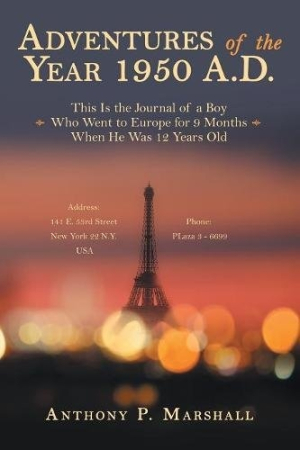Adventures of the Year 1950 A.D.
A fragment of a bygone era, this diary is a charmed look at how its young American author perceived postwar Europe.
Anthony P. Marshall revisits his childhood diary in Adventures of the Year 1950 A.D., an honest, unadorned, and nostalgic book that contains glimpses of midcentury life.
Written when he was twelve and on a transatlantic prep school trip to Europe, Marshall’s diary captures “an experience of a lifetime.” The diary is presented here as it was written, though with corrections for spelling (a handful of proofreading errors remain). Adopting a matter-of-fact voice, Marshall’s brief, chronological entries convey everyday events. They depict the stages of the trip, from packing and boarding the Queen Elizabeth to travels in France, Italy, Yugoslavia, Switzerland, and beyond, as well as the marvels of a first-time, months-long voyage. They also convey the mundane details of group travel.
Many entries begin in a similar manner, with the author and his classmates waking in the mornings, and conclude at nightfall, with the author writing in his diary. This structured record—replete with meals, travel logistics, and outings to churches, museums, and similar spots—is curiously impersonal, reading as though it were a field trip assignment. There isn’t a sense of unusual precocity, or the introspection found in diaries that have since turned into historical treasures. Instead, the work reads exactly as a schoolboy’s diary would, which results in languid pacing and the insertion of facts learned along the way.
The narrative’s youthfulness results in an appealing worldview; he is unwittingly droll. Impressions come across in passing asides. Of the Leaning Tower of Pisa, Marshall remarks, “It was leaning pretty much.” Of an unspectacular meal: “edible but one you would like to forget.” Such sprinkled wit adds vibrancy to the work.
Assessments of famous artists and their paintings also turn amusing in their guileless candor. There’s a refreshing novelty to the sites the author encounters; no matter how tourist-trodden, beauty still merits commentary, and the most impressive places leave the preteen wordless. Even in moments of weariness, illness, or homesickness, a portrait gradually emerges of a boy whose good nature allows him to view each new adventure with an open mind.
The entries, which span five months, from February to July, subtly reveal how the practice of writing and the passage of time lead to changes. April entries, set in Yugoslavia, constitute the highlight of the work. Impressions of communism and Tito’s presence give the entries a larger backdrop. From this point forward, the diarist begins setting scenes with greater attentiveness; descriptions turn richer with detail.
A fragment of a bygone era, this diary is a charmed look at how its young American author perceived postwar Europe.
Reviewed by
Karen Rigby
Disclosure: This article is not an endorsement, but a review. The publisher of this book provided free copies of the book and paid a small fee to have their book reviewed by a professional reviewer. Foreword Reviews and Clarion Reviews make no guarantee that the publisher will receive a positive review. Foreword Magazine, Inc. is disclosing this in accordance with the Federal Trade Commission’s 16 CFR, Part 255.

